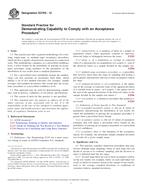Potřebujeme váš souhlas k využití jednotlivých dat, aby se vám mimo jiné mohly ukazovat informace týkající se vašich zájmů. Souhlas udělíte kliknutím na tlačítko „OK“.
ASTM E2709-12
Standard Practice for Demonstrating Capability to Comply with an Acceptance Procedure
Automaticky přeložený název:
Standardní praxe pro prokázání Schopnost pro zajištění souladu s schvalovacímu postupu
NORMA vydána dne 1.11.2012
Informace o normě:
Označení normy: ASTM E2709-12
Poznámka: NEPLATNÁ
Datum vydání normy: 1.11.2012
Kód zboží: NS-45902
Počet stran: 11
Přibližná hmotnost: 33 g (0.07 liber)
Země: Americká technická norma
Kategorie: Technické normy ASTM
Anotace textu normy ASTM E2709-12 :
Keywords:
acceptance limits, joint confidence regions, multiple-stage acceptance procedures, specifications, ICS Number Code 03.120.30 (Application of statistical methods)
Doplňující informace
| Significance and Use | ||||||
|
4.1 This practice considers inspection procedures that may involve multiple-stage sampling, where at each stage one can decide to accept or to continue sampling, and the decision to reject is deferred until the last stage. 4.1.1 At each stage there are one or more acceptance criteria on the test results; for example, limits on each individual test result, or limits on statistics based on the sample of test results, such as the average, standard deviation, or coefficient of variation (relative standard deviation). 4.2 The methodology in this practice defines an acceptance region for a set of test results from the sampled population such that, at a prescribed confidence level, the probability that a sample from the population will pass the acceptance procedure is greater than or equal to a prespecified lower bound. 4.2.1 Having test results fall in the acceptance region is not equivalent to passing the acceptance procedure, but provides assurance that a sample would pass the acceptance procedure with a specified probability. 4.2.2 This information can be used for process demonstration, validation of test methods, and qualification of instruments, processes, and materials. 4.2.3 This information can be used for lot release (acceptance), but the lower bound may be conservative in some cases. 4.2.4 If the results are to be applied to future test results from the same process, then it is assumed that the process is stable and predictable. If this is not the case then there can be no guarantee that the probability estimates would be valid predictions of future process performance. 4.3 This methodology was originally developed 4.4 Mathematical derivations would be required that are specific to the individual criteria of each test. |
||||||
| 1. Scope | ||||||
|
1.1 This practice provides a general methodology for evaluating single-stage or multiple-stage acceptance procedures which involve a quality characteristic measured on a numerical scale. This methodology computes, at a prescribed confidence level, a lower bound on the probability of passing an acceptance procedure, using estimates of the parameters of the distribution of test results from a sampled population. 1.2 For a prescribed lower probability bound, the methodology can also generate an acceptance limit table, which defines a set of test method outcomes (for example, sample averages and standard deviations) that would pass the acceptance procedure at a prescribed confidence level. 1.3 This approach may be used for demonstrating compliance with in-process, validation, or lot-release specifications. 1.4 The system of units for this practice is not specified. 1.5 This standard does not purport to address all of the safety concerns, if any, associated with its use. It is the responsibility of the user of this standard to establish appropriate safety and health practices and determine the applicability of regulatory limitations prior to use. |
||||||
| 2. Referenced Documents | ||||||
|
Odebírejte informace o nově vydaných normách ZDARMA:
Chcete pravidelně odebírat informace o nově vycházejících normách z celého světa a to zcela zdarma?
Přihlašte se k odběru. Vše je velice jednoduché a absolutně ZDARMA.
Na výběr máte vydavatele z celého světa.




 Cookies
Cookies
